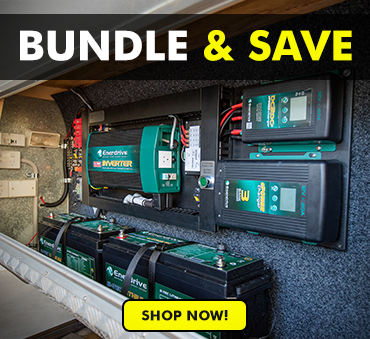Choosing the Best Camping Solar Panels:
When it comes to sunshine, Australia has it in spades. So, it only makes sense to use this free energy to power your campsite. But how do you choose the best camping solar panels for your rig?
Choosing the best camping and 4WD solar panels can be confusing, especially if you're not sure what you're looking for. Fixed or portable? Solar blankets or flexible panels? Monocrystalline or polycrystalline? Which size?
-
Follow Our Quick Guide To Choosing Camping Solar Panels:
Portable VS Fixed Solar Panels
Portable solar panels are great if you're on a budget or travel infrequently. They're easy to set up and simple to use because they require no installation and generally no additional wiring. You can simply place the solar panels in the sun and move them to "chase the sun" while a cable runs back to your battery. Just be sure to allow extra time for set-up and pack-down as you travel.
Fixed panels are the most popular 4WD solar panel choice. These panels are mounted on the roof of your caravan, camper trailer, boat or 4WD to absorb sunlight while travelling or when parked in a sunny spot. This comes with lots of benefits - they are simple to use, you can charge while on the road and you don't need to worry about set-up when you get to the camp. That said, your vehicle must be in direct sunlight to get the best results. You can lose around 20% of potential power if this isn't achieved.
If you're choosing fixed solar panels, think about where they will be mounted and the dimensions required.
-
Solar Blankets
Solar blankets are a great option for extended camping trips. The blanket is made from a flexible cloth backing and solar cells. The material provides you with the ultimate flexibility to hang the blanket from your car or simply lay it across the ground for the greatest sun exposure. The best part is you can quickly set them up and pack them down into a lightweight and compact unit that won't take up precious space. Now, solar blankets are a bit more expensive compared to solar panels but the lightweight design and convenience could be worth it.
Want to compare other solar blankets? Check out our blog here dedicated to the best solar blankets on the market.
-
Flexible Panels
While fixed solar panels can be rigid, heavy and require a bit of strategy when installing onto your caravan, motorhome or 4WD, flexible panels are just the opposite. The greatest feature of flexible panels is that they can be installed on vehicles with a curved roof with no additional mounting tools. They are also extremely lightweight while still being durable. Although these are a great option for caravans, RVs, 4WD's and even boats, beware that they aren't as secure as fixed panels due to being attached with adhesive rather that screws and bolts.
Solar Panel Cells
Without getting into too much technical detail, solar panels are made up of solar cells, which can either be monocrystalline, polycrystalline or thin-film solar cells. Each type has its own pros and cons, depending on how you plan on using your solar panels.
Monocrystalline (or single-crystalline) solar cells have a high efficiency rate, which means you can have smaller solar panels without compromising too much on power. Monocrystalline solar panels are also renowned for their longevity and durability. On the other hand, solar panels are most effective at a 90-degree angle to the sun and during perfect weather conditions (clear, sunny days). Shade, dirt and dust covering the solar panels can cause the circuit to break down. They also tend to be more expensive than their counterparts.
Polycrystalline solar cells are made using multiple crystals. While this can cause slight internal losses of energy, it does mean the panels can be placed at different angles. These solar panels are also good performers in lower light conditions and warmer climates (great for Aussie road trips). Because they are cheaper and easier to make, they are less expensive than the monocrystalline solar panels, and will still last just as long. They also tend to be slightly bigger than their counterparts to make up for the internal losses e.g. 180 watts is produced by one square of polycrystalline cells vs 190 watts for the same size of monocrystalline cells.
Thin-film solar cells (amorphous) are made using a completely different process than crystalline solar cells. Rather than using blocks of silicon to create cells, the silicon is placed in one or several thin layers on a surface to create the solar panel. They tend to be cheaper to make than crystalline cells. Also, because the photovoltaic material can be placed on flexible material, the solar panels to be attached to almost anything. High temperatures, shading and dust also have less impact on their efficiency. On the other hand, they tend to be less efficient than crystalline cells. In some cases, monocrystalline solar cells can produce up to four times more power than the thin-film solar cells in the same amount of space. So you need more solar panels.
Twin Cell Panels
New to the market are the Sphere Twin Cell Solar Technology solar panels.Sphere’s Twin Cell Solar Technology has been researched and developed in Australia and is an innovative solution to help reduce the effects of partial shading on your solar panels that many caravanners experience.
As any seasoned caravanner knows, partial shading on your solar panels from things such as your air conditioner or roof vent can cause a reduction in the overall power output. This means less power to charge up your batteries. Sphere’s Twin Cell Solar Technology helps to reduce the impact of partial shading. The unique design allows a single solar panel to operate as if it were two smaller panels as each side of the panel functions independently. If one half of the panel is covered by shade the other side will still operate at full capacity. This is a big advantage over traditional mono and poly solar panels.

Click here to compare solar panels vs solar blankets.
-
How Much Power Do You Need?
Take some time to work out what size camping solar panel you need, and you can save storage space and a few bucks. Think about what appliances you will be powering with your solar panels. For example, with camping fridges it's best to use the solar panel to charge the battery, rather than running the fridge directly from the solar panel, as the voltage will drop if clouds come overhead, for instance. By using the battery, your fridge keeps running even if the voltage output of the solar panel drops severely due to cloud cover. Choose a solar panel large enough to provide enough daily power to run your fridge, plus battery storage of an extra two-thirds on hand. A popular solar panel size to charge your batteries to run camping fridges is around 120 - 160 watts.
To assist further in choosing a solar panel size we have created a solar panel calculator. This will allow you to calculate the solar size required to run all your appliances and what size battery you'll need also.
Click here to use our solar panel calculator.
-
What's Your Budget?
If you’re on a budget, there are a few camping solar panels that offer great value for money, such as Enerdrive and Drivetech 4x4. The Drivetech 4x4 200W Portable Monocrystalline Solar Blanket and the Enerdrive 160W Folding Solar Panel Kit are both good options made of high quality monocrystalline solar cells!
-
Got more questions about camping solar panels? Ask our team!
DISCLAIMER* Please note, this advice is general in nature and we strongly recommend consulting the product manual and where relevant, a professional installer.
.jpg)












